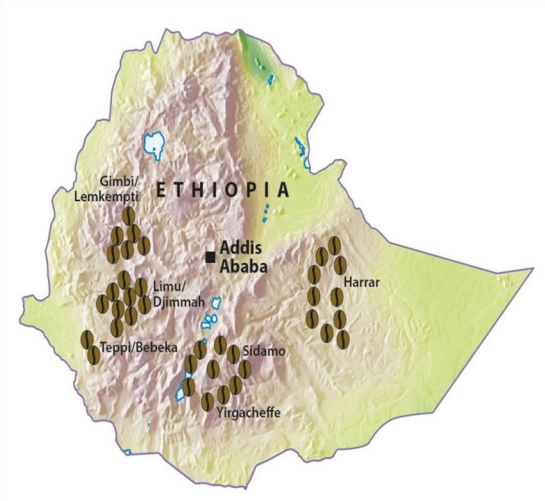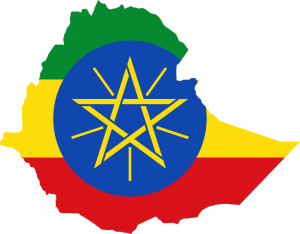Ethiopia Limu
About Ethiopia and it’s Coffee Production
Ethiopia is the birthplace of coffee: it is in the forests of the Kaffa region that coffee arabica grew wild.
Ethiopian coffees are available from some regions as dry-processed, from some regions as washed, and from Sidamo as both.
Kaffa (Kefa) is a province on the southwestern side of Ethiopia; its capital city was Bonga. It was named after the former Kingdom of Kaffa. The etymology of Kaffa is thought to be from the Arabic word qahwah meaning “a drink from berries”. The English word coffee is derived from the same root.
Where does the Ethiopia Limu come from?
The catchment area for Ethiopian Mocha Djimmah (Limu) is the largest in Ethiopia. These coffees are well known for their body and acidity. Limu coffee is grown in the Illubabor and Kaffa regions of Ethiopia at elevations ranging from 3,600 to 6,200 feet in the southwest/southcentral Ethiopia producing medium-sized coffee beans with a distinctive roundish shape and green colour, an area that produces and exports about 60,000 tons of coffee each year. Limu is a market name.
Coffee from Ethiopia is known for its bright fruited and floral flavours.
The beans are either washed or naturally processed. The processing method used has a huge impact on the final taste of the coffee.


Unwashed (Natural Dry Processed) vs Washed
There is a significant difference in the cup profiles between the natural dry processed and the washed.
Washed Sidamo, Yirgacheffe and Limu have a lighter body and less earthy/wild tastes in the cup as their dry-processed relations.
Ethiopian Djimmah is wet-processed (washed).
Washing coffee cherries results in a clean flavour profile in the coffee and represents an ideal processing method for those who prefer a brew that is both mild and bright. This processing method cuts and washes off the cherry from the coffee bean and also removes as much mucilage as possible. It is well-known for producing coffees that boast a light body and a bright clean cup.
The first step in the washed process is to take the raw coffee cherries, weigh them, then remove the cherry using a large mechanical de-pulping machine. Inside the machine, a blade cuts the cherry open, extracts the pair of beans contained inside, and then discards the empty cherries for other uses. The coffee beans, now left with a layer of mucilage, are set aside for mucilage removal by other means.
The mucilage is made up of a variety of different sugars and alcohols, which will affect the final flavour of the bean in a significant way if it is left on. Often in semi-washed and dry-processed coffees, where the mucilage is left covering the parchment and bean, a much sweeter flavour is produced. When left on the mucilage can significantly alter the structure of a coffee bean’s cells and will ultimately affect the types of notes that can be tasted.
Washed processing can be continued by either using a machine or by fermenting the beans, or completely by hand.
Tasting Notes for Ethiopia Limu
| Country of Origin | Ethiopia |
| Screen Size / Grade | Grade 2 |
| Bean Appearance (green) | |
| Acidity | |
| Body | |
| Bag Size | 60kg |
| Harvest Period | September to January |
| Description | |
| Tasting Notes | This coffee exhibits sweet, toffee apple flavours with a winey acidity and berry aromas. It is clean and crisp with nutty undertones. |
| Strength | |
| Processing Method | Washed (Wet Processed) |
| Altitude | 1400 – 1800 MASL |
History of Coffee in Ethiopia
Ethiopia is widely considered the birthplace of coffee. Many experts say that Ethiopia is the only place that coffee grew natively and the apocryphal story of Kaldi is told over and over. Kaldi was a goat herder who discovered coffee after witnessing the vigour that his goats received from eating the cherries.
He later brought these cherries to the monastery and shared them with the monks who exclaimed that they were the Devil’s work and hurled them into the fire. The aroma of the beans roasting in the fire was heavenly and the beans were raked from the fire and crushed to put out the embers. Realizing their mistake, they placed them into a jug and covered them with hot water for preservation. Later the monks drank the brew and it helped them keep awake during nightly devotions.
While this story is fun, in all actuality, it was likely that the people of the nomadic Galla tribe first discovered the coffee plant and its invigorating properties. Many such stories about the origin of coffee are apocryphal and its actual discovery is something of much speculation.
The rest of the coffee’s history in Ethiopia is quite turbulent. Ethiopia has undergone many changes in its government. In the past 40 years alone, they have had three forms of government, from a militaristic Marxist ideology to the federal system today. Each of these systems has been met with much public dissatisfaction, rebellion, and political upheaval. From 1998-2000 Ethiopia was involved in a war with Eritrea. This conflict with Eritrea (and much other dissension) have led to many deaths and great misery. It also limited access to land and created an economic downturn. The cost of the war was estimated at billions of dollars.
Amidst the turbulent political and economic climate, coffee farming in Ethiopia took a big hit. In 2003, the price of coffee plummeted lower than it ever has. The price of coffee was no longer covering the cost of production and, as a result, many farmers abandoned their crops. They were devastated, not having enough money to cover the cost of repairs to their homes, purchase clothing, or provide their children with an education. Many farmers migrated away from their farms to the city while others still remained with their coffee plantations.
Despite all of these hardships and challenges, coffee remains Ethiopia’s biggest export. At times, Ethiopian coffee farmers must compete and pair with larger companies with more power that often take most of the profit. Farmers make very little from these partnerships and women in Ethiopia’s coffee industry make even less, sometimes as little as 20USD a month. In 1957, the National Coffee Board of Ethiopia was formed to help improve the quality of Ethiopian coffee and to coordinate producers traders and exporters. And recently, Fair Trade organizations have been helping to ensure the fair compensation of coffee producers.
Ethiopia is now the world’s seventh-largest producer of coffee, and Africa’s top producer, with 260,000 metric tonnes in 2006.
Half of the coffee is consumed by Ethiopians, and the country leads the continent in domestic consumption.
Interested in some Djimmah?
Visit our Djimmah page or Espresso Bar to buy a bag of our Ethiopia Djimmah.
